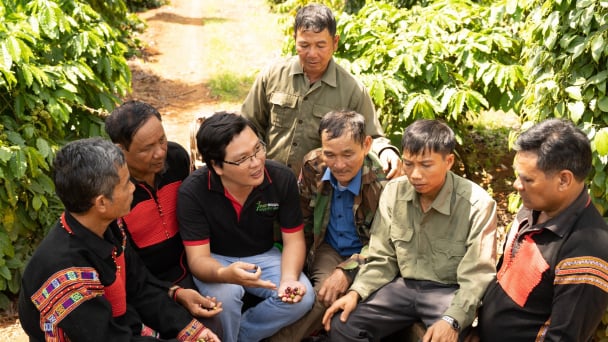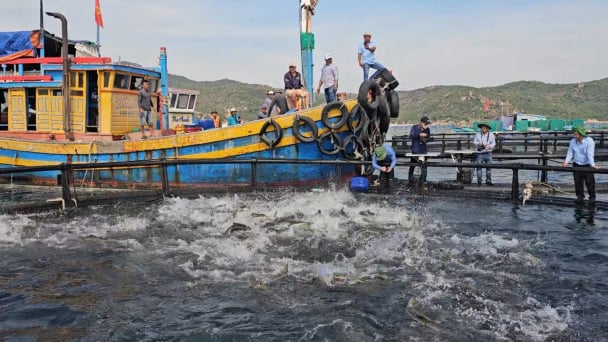May 24, 2025 | 16:29 GMT +7
May 24, 2025 | 16:29 GMT +7
Hotline: 0913.378.918
May 24, 2025 | 16:29 GMT +7
Hotline: 0913.378.918
The 100-ha wetland in Long Thanh village, Long Khanh commune, Tay Ninh is where farmers have intercropped rice plants and cassava; however, when the rainy season arrives, the risks are considered to be enormous.
Pham Hong Loi, a resident of the Long Thuan commune, disclosed that his standard of living was previously unstable due to his reliance on only wet rice. In addition to causing disadvantages for producers, rice monoculture reduced economic efficacy.

More and more farmers in Ben Cau district switched to growing biomass corn 2-3 crops per year thanks to its high economic efficiency. Photo: Tran Trung.
Similar to the situation with cassava plantations, Ngo Thi Thu An of Long Thuan lamented that dealing with cassava mosaic disease had been burdensome for years.
In recent years, ineffectual rice and cassava planting areas in some communes of the Ben Cau district have been converted to biomass maize planting areas, which can be harvested three months after planting, thereby protecting the crop from flooding. Multiple deep paddy can also cultivate maize in beds, and high paddy can produce two corn harvests per year. As a result, producers now earn significantly more than they did from rice and wheat plantations.
Due to many years of cultivation, the field of biomass maize in the Long Thinh hamlet (Long Khanh commune) is always bustling during harvest season. In the winter-spring and summer-autumn crops, corn has supplanted inefficient rice fields.

Most of the biomass maize fields in the Ben Cau district are consumed by dairy farms to make animal feed. Photo: Le Binh.
In recent years, the area of Ben Cau district that has been planted with biomass maize has increased swiftly, breaking the inefficient rice monoculture. Biomass maize is simple to cultivate, yields high profits, and is insured, so people feel safe expanding the area.
Traditionally, this region was primarily cultivated for growing rice, followed by wheat, sugar cane and corn seedlings. Along with the increase in the number of cattle in recent years, extensive fields specializing in cultivating biomass corn for cattle fodder have appeared in Ben Cau.
According to Mr. Pham Thai Huan, head of the Agricultural Extension Station in the district of Ben Cau, biomass corn was primarily cultivated in the winter-spring crop from 2014 to 2015. Due to stable profits at a high level and rising demand from off-taker partners, many farmers have recently contracted to cultivate biomass corn in a larger area during the summer-fall crop. According to the Tay Ninh Agricultural Extension Center, biomass maize is an advantageous commodity in the Ben Cau district due to the favorable soil conditions, expansive agricultural land, and lack of waterlogging.

Short growing time, low investment costs, and product consumption... so biomass corn has many advantages for development in Tay Ninh. Photo: Tran Trung.
Tay Ninh is recognized as the southern livestock industry's new epicenter. The "big guys" of the livestock industry in Vietnam and around the world are flocking to Tay Ninh to invest in and construct expansive farms.
The People's Committee of Tay Ninh Province recently organized the "Forum to connect businesses to invest in and develop the high-tech agricultural ecosystem in Tay Ninh Province in 2023" with great success. Therefore, more than 4,600 billion VND will be invested in the development of the high-tech agricultural ecosystem in Tay Ninh. This is also fueling demand for animal feed, which typically consists of biomass corn.

Thanks to the development of buffalo herds in Tay Ninh province, the demand for biomass corn in the coming time will be huge. Photo: Le Binh.
Mr. Trinh Quoc Dung, Executive Director of Vinamilk's Material Area Development, stated that the Vinamilk dairy farm (Ben Cau district) is in the process of preparing to increase its scope and implement modern technology in order to produce an additional 8,000 cows. Vinamilk dairy farm's entire dairy herd is anticipated to reach 16,000 heads, representing more than 62% of the province's total bovine population.
"Therefore, the dairy farm Vinamilk has an enormous demand for corn forage. In order to take the initiative in food sources, in addition to self-production, we signed a contract to periodically purchase agricultural products from more than 1,000 households in the province with approximately 50,000 tons of biomass corn and 4,000 tons of straw per year in order to process food for cows, as stated by Mr. Trinh Quoc Dung.
According to the Tay Ninh Agricultural Extension Center, after harvesting, the entire plant, leaves, and corn are placed in a shredder system for direct consumption by cattle or further processing into animal feed. To be able to consume products, however, farmers and cooperatives that produce maize biomass must adhere to quality requirements, particularly for safe production, and ensure the conditions of raw materials for dairy cattle farms.

Biomass corn will be purchased by Vinamilk in very large quantities to serve the goal of expanding the scale of dairy cows. Photo: Le Binh.
"Feed for dairy animals must have a transparent origin and comply with regulatory requirements. Farmers must use agricultural materials in accordance with a technical guide beginning with soil selection, vegetation control, and seed selection and extending through the use of pesticides, prevention of maize pests and diseases, etc. Director of the Tay Ninh Agricultural Extension Center, Mr. Ha Thanh Tung, stated that this is advantageous for producers because they do not need to spend money on pesticides and plant protection products, but can still ingest their produce.
Mr. Nguyen Dinh Xuan, director of the Tay Ninh Department of Agriculture and Rural Development, stated that the biomass maize cultivation model has been proven to be effective. Therefore, in the near future, the Department of Agriculture and Rural Development, via the Provincial Agricultural Extension Center and agricultural extension stations, will encourage farmers to increase their land area in order to increase their income.
"With the advantage of land and proven economic efficiency in the past, biomass maize will soon become a profitable commodity, contributing to the agricultural strategy of the province. Mr. Nguyen Dinh Xuan added, "We will also look for and connect with more product off-takers so that people who grow biomass corn can produce safely and increase their income."
Translated by Linh Linh
![Advanced mariculture – an inevitable trend: [1] Moving offshore](https://t.ex-cdn.com/nongnghiepmoitruong.vn/608w/files/phucpm/2025/05/18/0252-2436-nuoi-bien-6-162148_783.jpg)
(VAN) Mariculture using advanced technology and moving offshore is an inevitable trend, as nearshore areas increasingly reveal limitations.

(VAN) South Korea is currently the second-largest investor in Hai Phong in terms of the number of projects (186 projects) and the largest in terms of total registered investment capital, reaching USD 14.2 billion.

(VAN) As consumers become more environmentally conscious, legal regulations grow increasingly stringent...

(VAN) CJ Feed&Care officially launched the FCR improvement campaign called “2025 Find Challenge Reach” in April 2025. In Vietnam, this campaign is implemented by CJ Vina Agri.

(VAN) The swamp in Pho Thanh is gradually being covered with red mangrove, creating a favorable environment for producing clean, high-quality salt.

(VAN) The trade turnover of agro-forestry-fishery products is growing significantly, along with investment cooperation commitments that are opening up new development directions between Vietnam and Russia.

(VAN) Khanh Hoa is investing over 545 billion VND to develop 240 hectares of high-tech marine aquaculture in order to guarantee a consistent supply of seafood exports and achieve the USD 1 billion target.